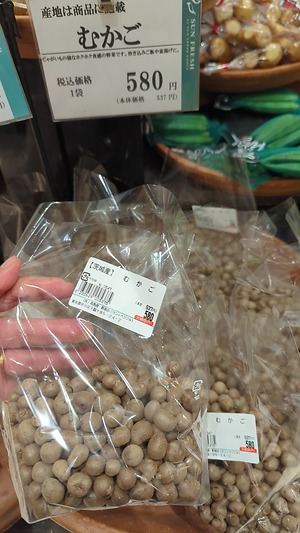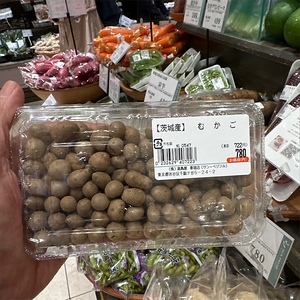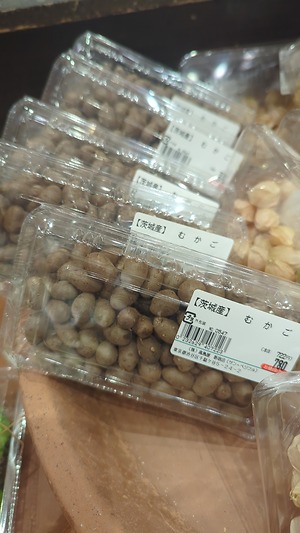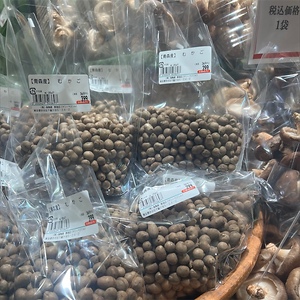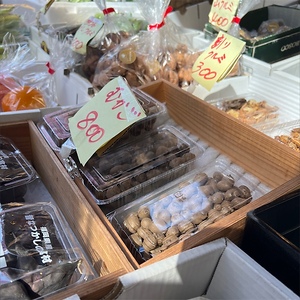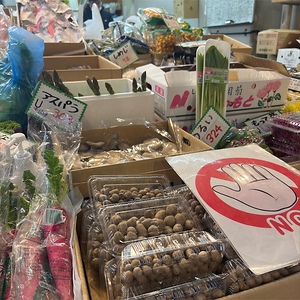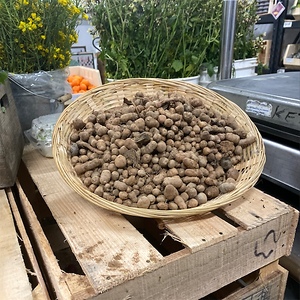


Tiny Mukago Potatoes
Estimated Inventory, lb : 0
Description/Taste
Mukago bulbils are small in size, averaging 0.5 to 2 centimeters in diameter, and are seen in irregular, oval, oblong, to round, lumpy shapes. Each bulbil has thin, taut, firm, and textured skin, sometimes featuring rough flakey patches across the tan, grey, brown, to dark brown surface. The skin also occasionally has tiny bumps or nodes. Underneath the skin, the ivory to white flesh is dense, hard, moist, and sticky. The flesh is inedible raw and must be cooked. Once cooked, the flesh softens and develops a fluffy, bean-like texture. Mukago bulbils are known for their earthy aroma and only bulbils with taut, plump, and firm skin should be chosen for culinary use. If the bulbils are too mature, they will develop a wrinkled nature. Mukgao bulbils can be cooked with their skin intact and have a mild, neutral, earthy, and subtly bitter taste.
Seasons/Availability
Mukago bulbils are available in the fall through early winter, harvested between September and November.
Current Facts
Mukago, botanically classified as Dioscorea japonica, is the name of tiny bulbils that seasonally form on various yam species belonging to the Dioscoreaceae family. Bulbils are small, tuber-like masses that are a part of the plant’s reproductive organs. Each bulbil contains the same genetic material as the parent plant and when it is released from the plant and drops to the ground, it has the capacity to sprout and develop a new plant. Mukago bulbils are sometimes referred to as Mukago potatoes for their similarity in use to potatoes in culinary preparations. It is important to note that the term Mukago may refer to several species of yams. In Japan, Mukago generally refers to the bulbils of the Japanese yam, also known as the Jinenjo yam, Wild yam, Japanese Mountain yam, East Asian Mountain yam, and Yamaimo. Mukago bulbils form at the base of the leaves on the yam’s climbing vine and one vine can produce over one hundred bulbils in a season. The bulbils are easily removed from the vine when ripe, and foragers often lay down tarps or hold umbrellas upside down beneath the plant. The vines are shaken, and the bulbils drop into the umbrellas or on the tarps for collection. Mukago bulbils are a seasonal autumn delicacy in Japan and are gathered from wild and cultivated vines. The small bulbils are favored for their mild, earthy flavor, fluffy consistency, and are a symbol of the arrival of fall, incorporated into a wide array of cooked culinary dishes.
Nutritional Value
Mukago bulbils have not been extensively studied for their nutritional properties. Some sources claim the bulbils may be a source of potassium to balance fluid levels within the body, vitamin C to strengthen the immune system, calcium to support bones and teeth, and magnesium to control nerve functions. The bulbils are also thought to contain amylase, a natural digestive enzyme that helps improve overall digestion and metabolism. Beyond the bulbils, Japanese Wild yams, in general, have been incorporated into natural medicines to reduce fatigue and restore overall health.
Applications
Mukago bulbils have a mild, neutral, earthy, and subtly bitter taste suited for cooked preparations. The bulbils must be washed before use as they are often covered in layers of dirt and flaking skin. Once prepped, the bulbils can be cooked with their skin on and are popularly fried as a bar snack. Fried Mukago bulbils develop a crisp, crunchy exterior and are tossed in salt or other seasonings such as miso, sake, sugar, cheese, mayonnaise or curry powder. They are also stir-fried, steamed with vegetables and meat, sauteed in garlic butter, or skewered on pine needles to develop a soft fragrance. In Japan, Mukago bulbils are popularly cooked into Mukago rice, also known as Mukago Gohan or potato rice. When cooked in this dish, the bulbils have a slight popping sensation due to their thin but firm skin and a variety of seasonings can be used to increase depth of flavor. Mukago bulbils can also be eaten in soup, especially miso, or tossed into chawanmushi, a steamed egg custard. Mukago bulbils pair well with gingko nuts, chestnuts, mushrooms, burdock root, carrots, lotus, turnips, and flavorings such as sake, soy sauce, mirin, and kelp. Whole, unwashed Mukago bulbils have a short shelf life and are recommended to be immediately consumed for the best quality and flavor. The bulbils can also be wrapped in a damp paper towel and stored in the fridge in a plastic bag or placed in a container filled with sawdust at room temperature and kept in a cool, dry, and dark location for a few weeks.
Ethnic/Cultural Info
Mukago bulbils are occasionally used as a seasonal ingredient in Shojin Ryori, a plant-based cuisine practiced in Japan. Shojin Ryori has roots in Buddhism and was thought to have arisen in the 13th century. Buddhism was introduced to Japan around 538 CE and several years after its arrival, daily habits, cuisine, and religious practices began to shift, beginning with Japanese Emperor Tenmu banning the consumption of meat from animals for a period in 675 CE. Later in the 13th century, founder of the Sōtō sect of Buddhism, Dōgen Zenji, wrote guidelines for cooking in monastery kitchens in his essay Tenzo Kyōkun. This written piece is thought to have inspired the birth of Shōjin Ryōri, roughly translating to “devotion cuisine.” The cooking styles of Shōjin Ryōri are prevalently used in Buddhist monasteries and temples, and dishes are comprised of simple cooking methods using seasonal vegetables. The natural flavors of the vegetables should be experienced in the dishes and using seasonal vegetables, including Mukago bulbils, allows the body to become balanced. Shōjin Ryōri also incorporates the principals of the “rule of five,” meaning the dish should be made with different colored vegetables with varying tastes for increased depth of flavor, aesthetics, and nutrition.
Geography/History
Mukago bulbils are a part of vining yam plants belonging to Dioscorea japonica, a species native to temperate regions of Asia, mainly in Japan, China, and Korea. The species has been growing wild since ancient times and is mostly documented in relation to its edible underground tubers. Mukago bulbils are a secondary crop seasonally gathered as a specialty culinary ingredient. The bulbils develop on the creeping vines of the plant and the species, in general, thrives in partially shaded areas of forests. Historically, Disocorea japonica was a wild species, but over time, the species was introduced into cultivation and is grown throughout Asia in limited quantities. Today, Mukago bulbils are found on wild and cultivated plants, frequently planted on farms and in home gardens. The species is primarily grown in the Aomori and Hokkaido Prefectures in Japan and are also seen in smaller amounts in the Nagano, Chiba, and Gunma Prefectures. Mukago bulbils are sold loose or packaged and are found through local markets and select retailers. They are also grown on a small scale in regions worldwide, including a few farms in California.
Recipe Ideas
Recipes that include Tiny Mukago Potatoes. One
| Savvy Tokyo |
|
Mukago - Gohan |



